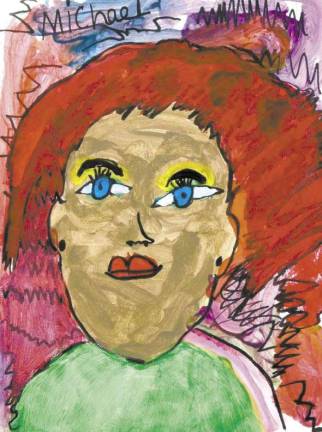When a polar bear is just a polar bear

An enchanting exhibit by school kids at the Met
By Joseph Smith
I wish more New Yorkers were aware of a show as intriguing, unusual, and beautiful as P. S. Art 2014, on view at the Metropolitan Museum through August 24.
This annual show represents artists in the New York City public schools, pre-K through 12th grade. Consisting of 77 works, it is produced by the New York City Department of Education, The Fund for Public Schools, the Studio in a School program, and the Met.
I am particularly intrigued by the work of the younger artists. I enjoy seeing how their vision transcends technical limitations. I feel as though they are inviting me into a slightly alien world (which I once knew), where images speak more clearly than words.
One of the first pictures we encounter is "I Visit Africa with Balloons" (mixed media) by pre-Kindergartner Luke Lyons. The adult mind may ask why "with balloons"? His answer would probably be: why not? Lyons merely wants to make us "happy" by sharing things he likes: a giraffe, zebra, rainbow, balloons, and blue shoes. It is not just that I feel disarmed by Lyons' frank desire to please, but touched by his trust-his assumption that we will enjoy what he enjoys. He draws me into his world. I decide I like zebras and blue shoes, too.
Through about third grade, the artists generally say that art is "fun," and that they want to make the viewer "happy." Some make no apparent distinction between the subject of the picture and the picture itself. To us, Mahamadou Kanuteh's oil pastel, "Big Polar Bear," is a vivid composition, in which the dense texture of the bear's fur contrasts with sky, snow, and stars. But kindergartner Kanuteh doesn't speak of artistic aims or technical means-what he wants people to know is "that I like polar bears" and tells us that "polar bears eat seals." To us, the picture is art; to Kanuteh, it is a bear.
At about fourth grade, the artists' comments start expressing more complex intentions. In "Under the Sea," fourth grader Jayme Diaz offers a mélange of sea creatures and flora in a dense pattern of interlocking shapes. Diaz, however, doesn't just want us to observe the creatures, but to identify with them. "I want people to feel that they are the sharks and other creatures under the sea. I want them to know that the ocean is a beautiful place, but it can also be mystical and dangerous." Diaz succeeds in achieving not just representation and pattern, but also a threatening mood.
"Handstand" by fourth grader Luis Rivadeniera must be seen at the exhibition rather than in the catalog or online. The fact that the hands are glued on separately gives them a prominence that is essential to the effect. The artist asks if we find the hand-stander "playful." Yes, and the artist as well!
Fifth-grader Austin Yeung gives his contribution the intriguing title, "Nothing's What It Seems." "I want people to think carefully about my artwork and not decide too quickly what it says." Indeed, the medium of chalk pastels enables Yeung to express ambiguity by means of delicate shadings.
When I read eighth-grader Steven Yang's comment that he created his "Meaty Rhino" (Photoshop) in order to "shock everyone," it recalled to me my own stormy middle school years. But the piece doesn't merely shock-even before I read the plaque or noticed that the material was images of meat, I was intrigued by the varied and detailed texture of the rhino's "hide."
With the work of the high school students, we enter a different kind of art show. Such pieces as, for example, Christine Chu's oil "Sliced Apples," Sharjeel Khan's ink drawing "Lawrence's Arabia," and Dereck Valoy's photo, "Harlem Meer Tree" are so mature and technically refined that the age of the artist no longer seems relevant. On one hand, this is a great compliment to these artists and their teachers. On the other, the younger artists offer a more unusual experience.
I wish the Met had listed the exhibition in its printed May-June flyers and directed visitors with a sign, but if you're looking for it, you can find the exhibit in the Uris Center for Education.
Joseph Smith is a pianist, and usually writes on music